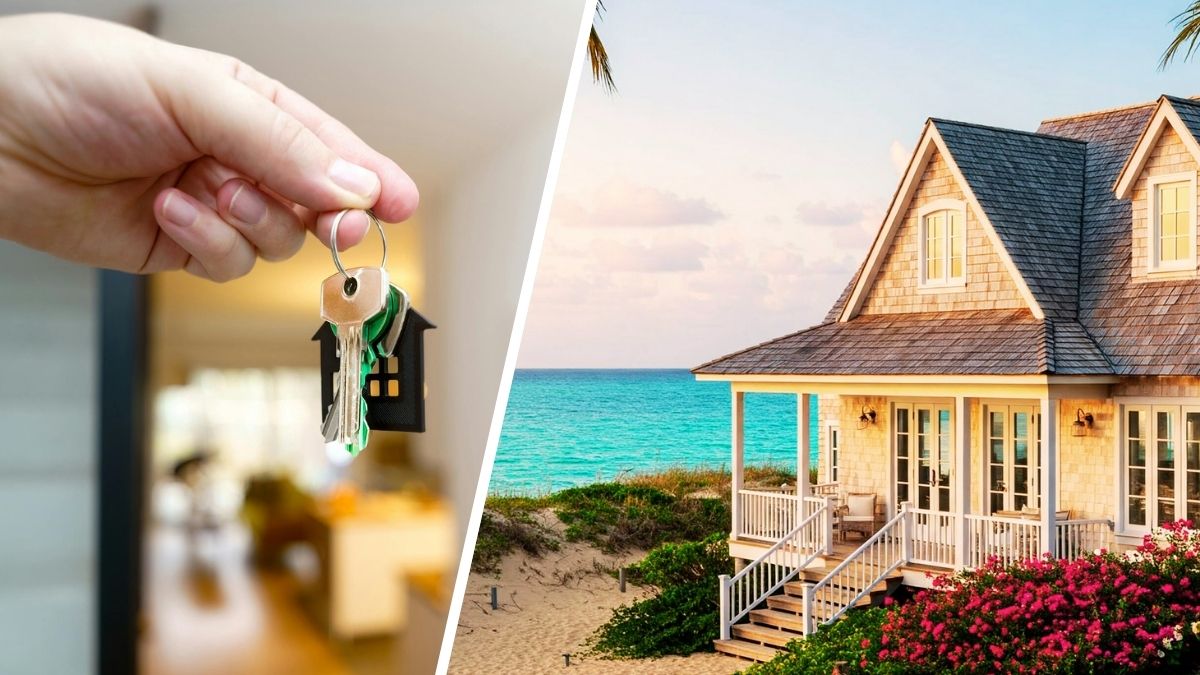
Whether it's a holiday home, an investment, or a future retirement haven, a second property is an alluring prospect. If you’re lucky enough to find yourself in a position where buying a second home is a viable consideration, there are a few things you’ll want to get your head around before you start firing off offers on every beachside apartment on the market.
For buyers not planning to purchase their second property with a lump sum or your first property’s equity, securing a second home loan will be necessary. If you’re still paying off the loan on your current property, you’ll need to satisfy your lender that you’ll be able to repay both loans simultaneously. There are a few things they’ll take into account.
What is a second home loan?
A second home loan is a type of mortgage used to purchase a property in addition to your primary residence. Unlike refinancing your existing mortgage, a second home loan is a completely separate loan tied to a new property.
People take out a second home loan for a variety of reasons, including:
-
Property investment – to generate rental income or build long-term wealth
-
Holiday home – for personal use during holidays or weekend getaways
-
Supporting family – such as buying a home for children or elderly parents
-
Planning for retirement – securing a future residence or downsizing early
Do second mortgages cost more?
They can, but it varies. Lenders tend to see second home loans as higher risk if you're taking on debt across two properties. To offset that risk, they often apply stricter lending criteria - including larger deposit requirements, more rigorous income checks, and a strong credit history. Interest rates may also be slightly higher compared to a standard home loan, depending on the lender and the loan structure.
Second home loans can open the door to lifestyle upgrades or wealth-building opportunities through property investment, but they also come with added financial responsibility. Before applying, it’s important to assess your ability to manage multiple loan repayments and ongoing property costs.
Investor home loans often come with different rates and features compared to standard owner-occupier loans. To help you compare your options, here’s a snapshot of investor home loan rates and offers from a range of banks and lenders.
| Lender | Home Loan | Interest Rate | Comparison Rate* | Monthly Repayment | Repayment type | Rate Type | Offset | Redraw | Ongoing Fees | Upfront Fees | Max LVR | Lump Sum Repayment | Extra Repayments | Split Loan Option | Tags | Features | Link | Compare | Promoted Product | Disclosure |
|---|---|---|---|---|---|---|---|---|---|---|---|---|---|---|---|---|---|---|---|---|
5.59% p.a. | 5.63% p.a. | $2,867 | Principal & Interest | Variable | $0 | $530 | 90% |
| Promoted | Disclosure | ||||||||||
5.44% p.a. | 5.35% p.a. | $2,820 | Principal & Interest | Variable | $0 | $0 | 80% |
| Promoted | Disclosure | ||||||||||
5.34% p.a. | 5.35% p.a. | $2,789 | Principal & Interest | Variable | $0 | $550 | 60% | |||||||||||||
5.44% p.a. | 5.48% p.a. | $2,820 | Principal & Interest | Variable | $0 | $595 | 80% | |||||||||||||
5.49% p.a. | 5.51% p.a. | $2,836 | Principal & Interest | Variable | $0 | $250 | 60% | |||||||||||||
5.54% p.a. | 5.77% p.a. | $2,852 | Principal & Interest | Variable | $15 | $484 | 60% | |||||||||||||
5.49% p.a. | 5.50% p.a. | $2,836 | Principal & Interest | Variable | $null | $null | 70% | |||||||||||||
5.59% p.a. | 5.60% p.a. | $2,867 | Principal & Interest | Variable | $0 | $0 | 80% |
Will you be able to afford the new loan?
Firstly, you will need to prove that your income is substantial enough to incorporate the new loan along with your existing debt obligations and expenses. The lender is likely to use a 3% serviceability stress test to assess your mortgage application, which means if you’re applying for a home loan at 6% p.a, you’ll need to demonstrate you would be able to make repayments if rates went up to 9% p.a.
If you’re still paying off your first mortgage, you’ll now also be paying off two mortgages, and unless the second home is used as an investment to generate income, it could be a tough ask. Both mortgages will eat into your incomes and the first could significantly hamper your serviceability with the second.
See Also: Borrowing Power Calculator
Are you still an acceptable credit risk?
You will also have your credit history assessed. If you were already approved for a loan on your first property and have had no problems since making repayments on time, this shouldn’t be much of an issue. However, any bills or debts you have been late paying in recent months might be flagged by your lender and possibly referred to the credit analysis department.
Is the loan too risky for the bank?
Another potential hurdle is the loan to value ratio (LVR) on the new loan. This measures how big the loan is relative to the property value: an $800,000 loan on a property worth $1,000,000 would have an LVR of 80%. High LVR loans mean a heightened risk for the lender of a negative equity position in the event you default on a loan.
If the value of the property has fallen below the outstanding loan amount, the lenders will still be at a loss even if they repossess. Lenders are therefore more sceptical about high LVR loans, and may charge lenders mortgage insurance (LMI) or higher rates to mitigate these risks.
You might be able to use equity in your existing property to offset this, which we’ll discuss in more detail later, but keep in mind this puts your home at risk if things go south.
Will your debt to income ratio be too high?
If you intend to simultaneously pay off two home loans, one concern is that you might be prevented from getting a new home loan if your debt to income ratio (DTI) is too high. As the name suggests, this measures the size of your debt obligations relative to your income. For example, if you make $100,000 a year, and have $300,000 outstanding on your mortgage, as well as $25,000 on a car loan, your DTI would be 3.25.
Lenders will have different standards, but will often have a debt to income threshold that borrowers cannot exceed. Many lenders are reluctant to grant home loans to anyone whose DTI exceeds 7.5.
Is it worth buying a second home?
Most lenders have algorithms that work out whether your application is successful. They will plug in all or some of the above factors, and the system will work out whether you pass or fail. For example, many banks use the Household Expenditure Measure (HEM) to calculate your expenses, which may not be accurate to your own situation.
It’s worth assessing your own situation as well and see how confident you are in your ability to repay another loan rather than relying on the bank's commitment to responsible lending. You can use our borrowing power calculator as well as our mortgage calculator to find out how much you could borrow versus how much you’d actually be comfortable borrowing.
You might be thinking it’s a relatively risk free endeavour, since the new loan is secured against your second property, not your first home. Worst case scenario, if you become unable to make repayments, you lose your holiday home or investment property, not your family home.
Due to recourse lending rules in Australia, should you default on the second mortgage and the bank fails to get what they’re owed, they could come after your first home as well.
Keep in mind also that it isn’t just about the serviceability of the loan. Properties inevitably incur additional expenses; you might want to undertake renovations for example, or need to fully furnish the place. Maintenance, property management fees and other little expenses should also factor into your calculations.
Keep in mind too many Australian states have different land tax obligations for second properties, as well as more onerous stamp duty obligations than if you were a first-time buyer.
If your current financial situation is uncertain, or you’re planning significant life changes (starting a family perhaps, or a change in career), it might be worth holding out on that second property until things are a bit more stable.
What to consider when buying a second home
Once you decide it’s time to add a new property to your portfolio, there’s a few things to consider when making your choice.
Purpose
There are a bunch of different reasons you might elect for a second property. From the outset, it’s a good idea to have a concrete plan for what you intend to do with the property. You presumably don’t want to buy a holiday property with a vague idea of retiring there one day, then eventually doing neither and having it sit there gathering dust.
Location
When you know what you want a second property for, this will inform where you should be looking. It might not be a good idea to buy a beachside apartment for holidaying that’s a seven hour drive away, for example.
Location is also one of the most important considerations in working out the financials of the deal. Where a property is can be one of the biggest factors in how much it appreciates or depreciates in value, as well as how much it could earn in rental income should it you end up renting it out.
Further, many lenders have restrictions as to where they will lend to a property.
If you’re interested in learning more about where to find property with big earning potential, you can check out our guide to choosing a suburb.
Financials
You might be confident you have the financial muscle to afford a second property, but that doesn’t mean you should be blasé about how you purchase the property. You might choose to use equity in your existing property for example to help bring down the LVR of your new loan, potentially lowering your interest rates.
Talking to a financial advisor or another expert could help you figure out the most cost effective way to get hold of your new property.
Requirements for a second home loan
Here’s a list of the requirements you typically need when applying for a second home loan:
-
Proof of identity, such as a passport or driver’s license
-
Proof of income, e.g. recent payslips, latest tax returns
-
Bank statements to verify expenses and savings
-
Statements for current mortgages and other debts
-
Demonstration of strong credit history
-
Deposit from savings or from equity released on your current property
-
Recent rates notice
How to use equity to buy a second home
You might be able to use equity in your existing property as a deposit to purchase a second one. Equity measures how much of your property you own outright. You calculate it by subtracting the outstanding loan amount you owe from the current value of the property.
To protect themselves from the risk of negative equity positions, most lenders calculate your usable equity using 80% of the property value. For example, you might owe $500,000 on a house worth $1,000,000. Your usable equity would therefore be $300,000 (80%*$1,000,000-$500,000).
Refinance or use a home equity loan
There’s a couple of ways you can use equity to purchase another property. Firstly, equity could be a means to buy a second home without a deposit. You could refinance, borrowing more money against your usable equity and use this as a deposit for the next property.
In the above example, you would be able to take out up to $300,000 on your existing home loan. This would be a hefty deposit on a new property, likely with a low LVR, which can mean lower rates and not having to pay LMI on the new loan.
Cross-collateralise the loan on your existing home
Alternatively, you could cross-collateralise, and use your existing property as security for your new purchase. In this case, instead of taking out $300,000 from the existing loan, you would borrow the full amount of the new property, but put up your usable equity as additional security on the new property. This lowers the LVR, as the $300,000 would be added to the value of the new property as collateral.
While using equity in your existing property can be a money saving move, it also means you expose your home as well as your new property if your financial circumstances change.
Turning a second home into an investment property
While you may be purchasing the property as a holiday home for your own regular use, meaning you don't plan to rent it out, that could change over time.
Rental income can be a great way to offset your home loan repayments, but you’ll also have to factor in increased responsibilities for the upkeep of the property, as well as the fees for marketing and property management.
There are also different rules for properties depending on whether they are investments or owner-occupied. It can change your land tax obligations and the interest rate you pay on your home loan, among other things.
If you are paying off the loan as owner-occupied, you might need to refinance and change it to an investment loan. This might help satisfy both the tax office and your lender. It's worth consulting a financial adviser to figure out your obligations and to get your affairs in order.








